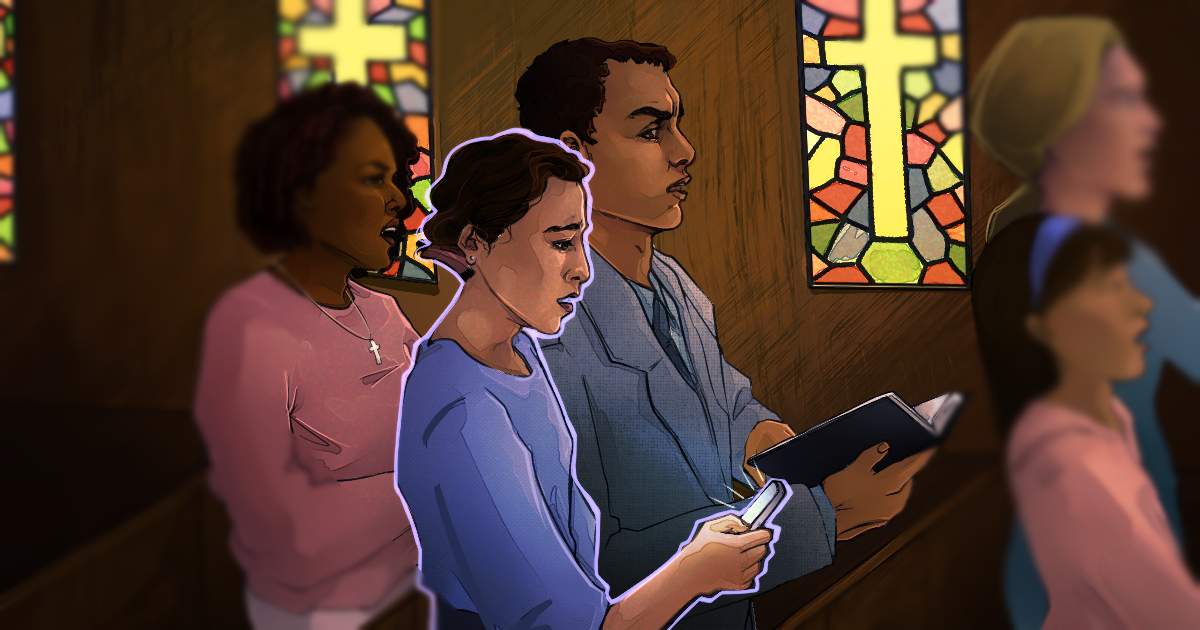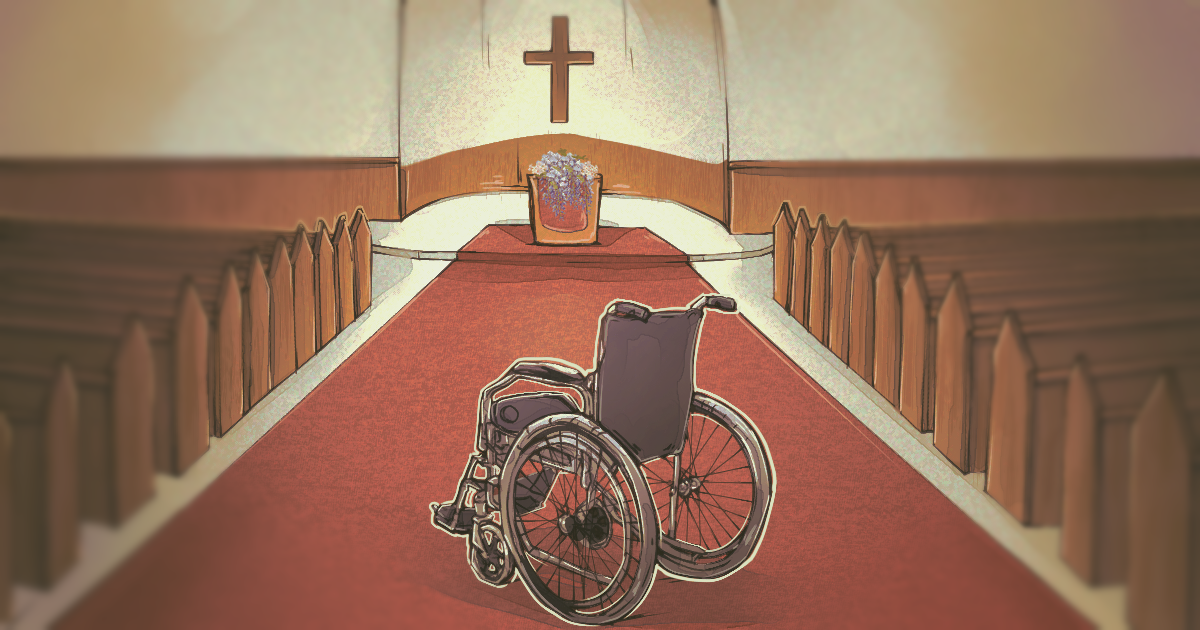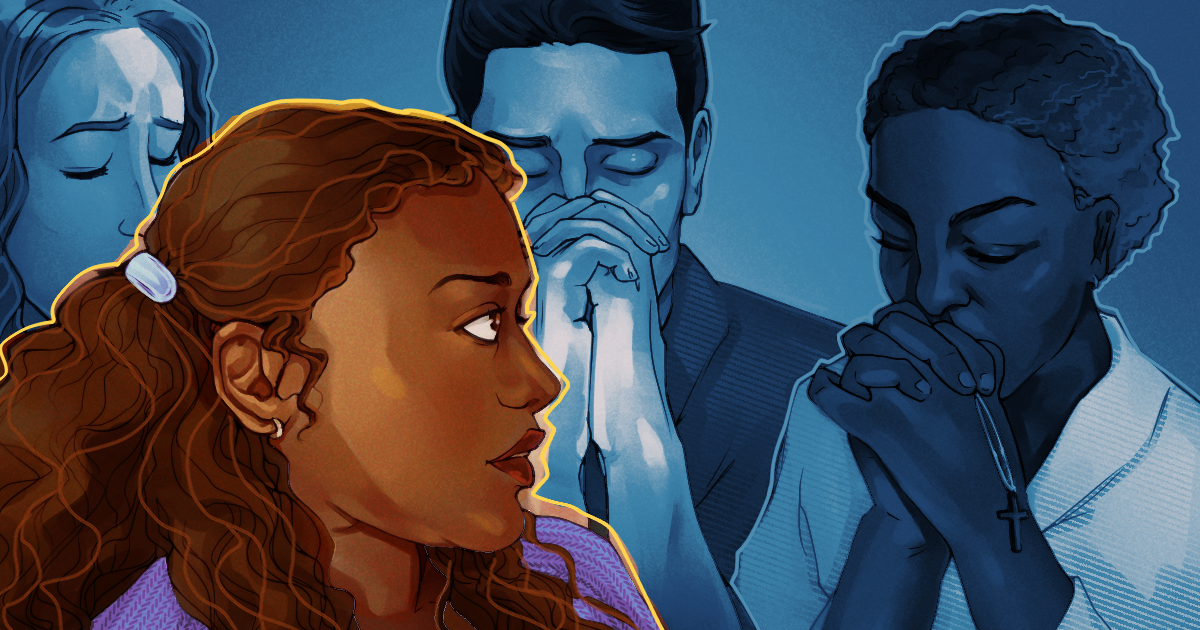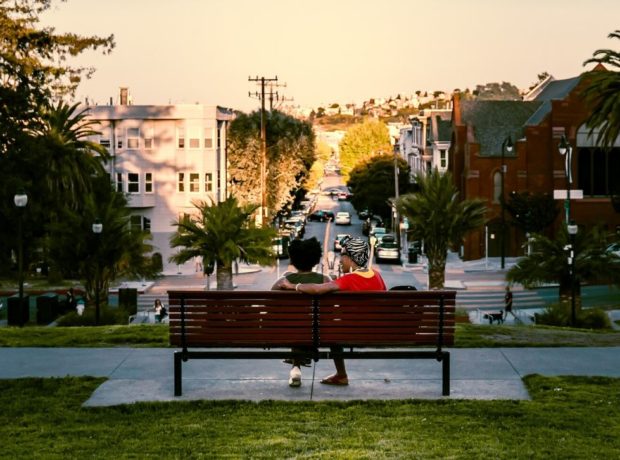While some see faith spaces –churches, mosques, synagogues or temples – as safe havens, the reality can be starkly different for the most marginalised. Mina Hadi interviews two writers whose book invites 30 disabled people to share their experiences of access and exclusion in UK churches.
Writers Dr Naomi Lawson and Emily Richardson, both disabled Christian activists, are seeking solutions to improving access and participation for disabled people. Their book, At The Gates, is a collection of stories exploring the experiences of disabled people who have borne the brunt of institutional ableism in faith spaces.
By sharing the personal testimonies of disabled Christians, who are referred to as “storytellers”, the writers are stressing the importance of listening to those with lived experience.
The book explores stories like Jemma’s, whose PTSD was accommodated only after being publicly triggered, and Fern’s, who was wheeled precariously into an inaccessible church up “what felt like a 180-degree staircase on two planks of wood”.
There is diversity between different churches and different denominations, and the anecdotes of the book’s 30 storytellers won’t necessarily apply to all. But they deserve investigation and invite every church to ask questions of itself.
Writers Naomi and Emily share stories of physical exclusion, digital exclusion, financial exclusion, and exclusionary language, as well as reflecting on the toll these take. For people of all abilities, the Covid lockdown has triggered a reflection of what could be as well as what currently is. With these real-life stories, the writers invite churches and all faith spaces to reflect on the issues highlighted.
How has the Covid-19 pandemic affected access for disabled people of faith?
The book’s storytellers explore how hybrid or online churches improved accessibility during Covid lockdowns, something that other disabled congregants have affirmed in the UK and the US.
Co-author Emily writes about the increased sense of freedom that “bed-based disciples” – disabled people delivering faith services from home – found during lockdown. Delivering online sermons saved her time and the fatigue of getting into church buildings.
Similarly, storyteller Emma was restricted by accessibility issues in her church, but when services moved online, Emma had crucial knowledge in how to run a “Zoom Church”. She says she has been able to reach people, even those who may be digitally excluded – by sending audio versions of services on CDs to nursing homes, and helping people in their nineties to get on Zoom.

The book candidly reflects the mixture of “hope and frustration” felt by disabled people when services moved online during lockdown. The apparent lightbulb moment for faith spaces – previously reticent in providing services online for disabled congregants – felt dimmed by the frustration that digital access couldn’t have been granted sooner.
Pre-Covid, the lack of suitable, accessible online church services led storyteller Fern to attend an online church in Australia, despite living in the UK. There, she felt a sense of community, despite the fact that she would “never physically be in the same room or even the same country” as the other congregants.
From the outset there was an understanding that this was a temporary measure, as congregations would eventually return to “normal” – meaning in-person services – once the pandemic subsided. This felt like a somewhat bittersweet victory for disabled worshippers. The power imbalance that disabled congregants felt still lingered.
The move felt more like one of expedience – “accidental access”, as Naomi refers to it – than compassion or understanding of the needs of the disabled community.
Emily highlights a storyteller, Kt Tupling, who set up a group called Disability and Jesus. She says: “She spoke about how it was like the church was being forced into this digital space against their will. And yet they still felt the need to immediately be the expert, without really acknowledging that there are people who know how to do this already.
“They weren’t listening to us, those who had already found ways of doing a lot of these things. The necessity of going digital because of Covid helped because everyone was there, so we had a wider audience. But we did feel, once again, that marginalisation from a space that we built on our own.”
The expertise of book’s storytellers was dismissed or resisted on multiple occasions. Storyteller Hazel asked her church if she could redesign their website to make it more accessible for herself and her husband, Victor, who are both visually impaired.
Testing websites for accessibility was something she did professionally, and yet her expertise was ignored – perhaps because it related directly to her disability. Viewing her disability as a strength, rather than something to her detriment, didn’t fit with the more traditional pastoral model of what a church should be.
The Inclusive Church is a charity that works with churches in improving accessibility. In 2022, they did a consultation about the accessibility of churches during the pandemic, or lack thereof. One focus was the different formats of worship – hybrid, online and in-person. When it came to hybrid church, tech problems came up repeatedly, including equipment that was too expensive or not always working.
Emily and Naomi agree. They explain that due to inaccessibility, disabled congregants had flocked to online spaces long before the pandemic and so were more accustomed to overcoming potential roadblocks than services that had never been held online before.
So much of the rhetoric when the pandemic began was around the “new normal” of life under lockdown. And as lockdowns lifted, this term returned to describe what lay ahead. Naomi says: “It really felt marginalising because we felt like the ones who were not normal. There was a lot of discussion about how there should be the mainstream provision and then the church will reach out to those who are sick. But we don’t want to be reached out to; we want to be an integral part of the community.”
The writers stress the incongruity of a “one size fits all” approach, whether when considering Covid more widely or for specific marginalised communities. Even though bringing services online helped many disabled people, this was by no means felt universally across disabled communities, nor should it be when needs differ so much. Emily specifies barriers that disabled people faced accessing online faith services, such as digital poverty and the difficulty of being on video for neurodiverse people. These barriers were reflected in other groups and outside faith spaces as well.

She believes the answer is not to have services automatically default to being either online or in person, but rather, offering a range of responses, rules and formats so everyone is included.
A recognition that disabled people are more likely to get seriously ill or die from COVID should have prompted more caution in reopening faith spaces as they did in the summer of 2020. The book stresses that the way in which a faith space reopens is vital – as is the understanding of who gets left behind, and the fact that the pandemic is still not over.
“It’s about knowing what the barriers are and being willing to spend time dismantling them,” Naomi says, “and that can be difficult in churches where things are done in a set way. Places of worship need to think about the diversity of their congregants and their needs, and they can only know that by listening to them.”
Post-lockdown, how has access online and in person changed? Have churches continued with digital services and are they consulting the disabled community?
Some accessibility features are now built into certain video conferencing and social media platforms. Zoom allows for closed captioning, as does Facebook. These aren’t perfect, Emily notes, but they are a good start. However, some disabled Christians reported not having closed captions – which are automated and not always accurate – when services were virtual. So even these small, imperfect but theoretically easy wins have proven difficult, especially if there is a lack of knowledge about technology.
Naomi says they try to organise a BSL (British Sign Language) interpreter for events, because there are BSL users who may want to attend. However, the struggle with this in places of worship can come down to cost, time and diversity in demand. Andrew, who is Deaf, asked for subtitled church sermons, but was told this was not worth the cost for one person.
One deaf storyteller, Shona, recounts being on a pilgrimage and being asked if she wanted a lip-speaker. Expecting to only be able to lipread part of the service, she was pleasantly surprised when the priest lip-spoke for the entirety of the service and his sermon, making that accommodation for her despite the sermon’s length.
Storytellers also talked about their use of assistive technology and how this aids communication for nonspeaking and visually impaired people through their smartphones.
Rhona, who is visually impaired, recalls first using her phone during services to read hymns in large print six years ago. The reception she got then was one of “tsking and […] tutting” from disapproving congregants, who mistook her use of technology for non-engagement.
Since then, Rhona admits things have changed, but that this is because of “accidental access” from the rise of smartphone use by non-disabled people in faith spaces.
How does the church’s “pastoral model” affect disabled people?
At the Gates frequently critiques the traditional pastoral care model found in churches, which focuses more on caring for rather than working with disabled congregants to facilitate participation. This mindset is a reflection of ableist theology that reinforces harmful ideas about disabled experiences.
Storyteller Mary was in a leadership position at her church when she was pressured into being counselled by a fellow congregant, who was unqualified to support her with her mental health issues. She had been upfront with her church about this from the outset. Mary was not given a choice in the matter, and the unqualified counselling increased her distress.
Similarly, in seeking a role as a minister, Esther reported being asked discriminatory questions about her mental health. Even when her church was supportive of her being ordained and her accessibility needs, Esther’s ministry depended on a medical assessment that failed her.
It took a great deal of emotional labour on Esther’s part, gathering documentation from mental health professionals and church leadership to vouch for her before she was ordained.
The many hurdles that these disabled people had to clear to attain leadership positions is indicative of the structural inaccessibility of many faith spaces.
The book notes that most events on disability inclusion in faith spaces tend to be led by non-disabled people. Disabled people are talked about “as objects of theology”, the book narrates, primarily in a deficit driven way, where giving access is seen as a barrier for that church – particularly when they claim to have financial constraints.
Worse still, the legal duty faith spaces have in ensuring access to disabled people is openly talked about as a burden. The book references “a lament from the church leaders present” at church conferences: “What is the least we have to do, to comply with the Equality Act?”

Storyteller Mims advocates for a different approach that centres lived experience, empowering disabled people to speak for themselves rather than have others speak for them.
The book lists some alternative models that focus more on power-sharing, such as emancipatory disability research (coined by disability researcher Mike Oliver in the 1980s) and citizen participation.
In the faith spaces themselves, storytellers discuss being approached and touched by strangers, being prayed over – often in a dramatic and performative fashion that objectifies disabled people.
This fixation on being “healed” through prayer has proven harmful and even fatal. Kathy Black is a disability theologian and author of The Healing Homiletic, which also focuses on ableism in North American churches. Black recalls the story of Sig, who was told by his church to stop taking medication for his epilepsy that could have prevented his death from a seizure. Sig’s church told him he could be healed from epilepsy if he had more faith, but the result was a life needlessly lost.
What impact does language have on disabled access to faith spaces?
At The Gates details some of the ableist stereotypes in Bible interpretations, such as the use of blindness and deafness as synonyms for ignorance or sin, and disability being the result of a lack of faith.
“This is a real problem that disability theologians have talked about,” Naomi says. “[The Bible] can reflect ableist attitudes. You get, for example, Jesus calling people ‘blind fools’. There’s a lot about blindness and deafness, from the Old Testament to the New Testament. The first thing is to draw attention to that, even though it will make people uncomfortable. Addressing it, though, is a much more interesting question.”
Emily says, “I’m thinking of the book’s cover, by Dr Rachel Holdforth. One way to address this that I’ve seen is through art and through reconsidering these terms. So we’ve got the sighted disciple leading a blind Christ on the cover. And at the Disability Conference we have every year, a lot of thought goes into the liturgy and hymns we use.
“There’s a lyric that is ‘I once was blind, but now I see’. And it is hard when these songs are so loved, but it is that more creative way of playing with our text and images. A lot of disabled Christians on the edge are the ones doing that.”
The traditional model in many faith spaces appears overly paternalistic, backing disabled congregants into the suffocating corner or dangerous cliff edge of needing to be looked after. But in At The Gates, the emphasis is on disabled people having autonomy, being capable of actively changing their environment to make it more inclusive themselves.
The question is not whether language matters; clearly, it does. But is it enough to change language alone when the problems are far more deep-rooted and structural?
Naomi says language must be part of the conversation about accessibility, even if the buck doesn’t stop there: “Language helps to create attitudes, but it’s not the only place attitudes come from. We need to look at our ableist language as part of our ableist culture more widely. Language is one aspect; access is another.
“Everybody currently wants to tell me that this is not about access, but all these things are equally important. People participate physically and culturally, and to get to that point, you need to feel safe in your community. That includes language, because you could be thrown out of a beautiful worship song, if it’s suddenly using language that makes you feel like an object or devalues you. So, I would say it’s an important part, but it’s one of many ways culture transmits ableism.”
The frequently used direction “please stand” fails to consider disabled congregants who may be unable to, potentially inviting judgment from fellow congregants who take this to mean that someone sitting is not adequately participating. So, for storytellers Susanna, Clare and Faith, the more inclusive phrase “Stand if you are able or sit if you’d prefer” made all the difference.
How can the disability justice movement be more intersectional?
Overcoming barriers to faith spaces requires an intersectional approach, taking into account factors such as race and gender. As a researcher, Naomi recognises the prevalence of certain demographics in the book’s storytellers and the lack of others.
“The movement is quite white,” Naomi says, “and there are definitely missing intersections that we need to work on bringing in as a movement.”

Naomi points to Black disabled leaders already engaged in much of this activism, such as Dr Lamar Hardwick, known as the “Autism Pastor”, whose book, Disability and the Church focuses on race, disability and the church.
“We have to consider whose perspective is not there, because there’s always someone missing,” Emily says. “It’s just having that awareness and listening to that voice in the back of your head asking whose experience is being ignored. So, whether it’s the Black experience, or women, or LGBT people – it’s remembering the intersections that is the most important.”
What role does class and income have on disability justice?
Emily points out that disabled people are more likely to live in poverty. Even before the cost of living crisis, a lot of disability justice work has been done from the breadline. “We need to acknowledge that there is a cost in belonging to a church,” she says. “So whether that’s repaid financially or just with time and appreciation, it’s important to everyone within that place of worship, not just disabled people.”
One of the book’s storytellers, Rhona, reflects that there is a “double problem of poverty with disability.” This is illustrated by Rhona’s recollection of wanting to attend a Methodist mental health conference. She was unable to afford the £150 ticket. After she informed the organisers that she was on benefits, her request to pay the ticket price in instalments was refused.
Other storytellers, like Emma and Deirdre, struggled to access literature that explored the theology of disability. The book notes that academia on the theology of disability is often about disabled people and faith, but not by disabled people of faith.
“There is definitely a link between poverty and disability,” Emily says. “As someone on benefits, I would love to read all the books, but I don’t have the funds to buy everything. Communities do come together in recognition of financial barriers, though. When we organised the Disability Conference, we offered subsidised and free places to those facing financial difficulties. There’s also an online church community we mention in the book called YouBelong, and they’re creating a library of books. At The Gates is one of them.”
Naomi adds: “These conferences initially expected rich, educated people, mostly men, to come along and talk about mental health. They didn’t expect people with mental health issues to come along. If they had reversed their idea of considering who would need this conference, they might have started with people with mental health issues and how they may live in poverty. But they were still thinking along this pastoral care model of the church looking after people.”
How can disabled activists support each other to avoid burnout?
When this paternalistic attitude is the norm, breaking away from it and rejecting it can be tiresome. Both Naomi and Emily acknowledge the impact of talking about personal experiences, the emotional labour that can fuel it and the subsequent burnout. The undue pressure is on those most marginalised in a group to take the time to educate those around them, rather than the onus being on the person with privilege.

“During the Black Lives Matter movement in 2020,” Emily says, “there was a tendency for well-meaning activists to go up to Black people and say, ‘What do I need to do?’ There’s a thing called Google. There are ways of educating yourself without continuously having to reach out to people with lived experience.
“I really appreciated Naomi the other week,” Emily continues, “when someone on Twitter had asked them for resources, and they said, ‘I can’t do that right now. I need my time. There are others you could ask.’”
“I’ve always said ‘I want to help’,” Naomi says, “but the impact on us can be quite high. So sometimes you just point people to others doing similar work, to spread the load.”
Emily agrees: “Particularly in disabled Christian work, a lot is emphasised on the need for rest. That’s something we really forget to do.
“People in the community have taught me so much about having that courage to say no to things, and that I need a day off. Again, it’s that internalised ableism of ‘I need to be productive, I need to be doing things’ – because when I’m productive, I have worth. But actually, you have worth, regardless of your ability to work or do things. And every time I relearn that, I feel more grounded.”
The concept of self-care has Black feminist origins, with Black civil rights activist Audre Lorde describing it as “self-preservation” and “an act of political warfare”. Within the disability justice movement, activists are good at encouraging each other to take rest.
“The other day,” Naomi shares, “I got an email from [fellow activist] Fiona MacMillan. She told me, ‘You’ve been doing an awful lot – slow down a bit.’
“Lots of us do the same for each other. And this is something that the disability movement has been teaching other activist movements.
“There’s this idea that you must be out on a march or you’re not an activist. Online activism isn’t seen as good. And we’ve said that some people will only ever be able to do online activism, and that really matters, because you’re educating people. This is important work, but the world won’t end if we have a day off.”
Significant emotional labour goes into being activists, but there is also the work of simply asking for access – something everyone should have a right to.
To cope with this, Emily recommends finding the communities on the edge. “For me, that’s been social media,” she says. “Finding other people who are in the same situation and have come up against the same barriers or may have ideas on how they navigated certain hardships. You can do a lot of the groundwork with the community, because we share so much expertise between us.”
Other storytellers in the book speak about the emotional labour that goes into asserting themselves when asking for access. Disabled congregants flock to social media for different purposes. Those looking to feel safe with others like them and speak more openly about their struggles say they prefer closed Facebook groups. Those looking to start conversations about access more publicly are involved in more outward-facing Twitter groups.
Accessibility is an uphill struggle that can take a long time.
“I just had an email exchange with one storyteller,” Naomi says, “who is finally making progress at her church after a barrage of difficult experiences. This person’s church is really struggling with the basics but is finally starting to listen, but that’s after a decade long struggle. It takes a lot out of a person. And not everyone can advocate for themselves in that kind of way.”
“People have been really lovely,” Emily adds, “especially the storytellers in the book, in realising that they’re not alone in their stories. Some thought they were the only person in this situation and now they realise that their story is one in this whole big picture.”
Naomi says: “The more we can talk about this, and it enables people to speak, the more things will hopefully change. Even ten years ago, before the Disability Conference started, I thought maybe there were just a few of us. Lots of us felt really alone until recently. There is safety in numbers, in understanding that it’s not just you being difficult. There’s real ableism going on here, and it’s okay to criticise it because it needs to change.”
The outlook of the book is one of realism. Those telling their stories are forthcoming in their critiques of the deep-rooted ableism in the very foundations of many churches – right down to the inaccessible architecture of some and paternalistic attitudes of others. But this book is also hopeful, and a call to action, a blueprint for faith spaces on how to be more inclusive and the lessons learned from the pandemic. At The Gates calls for a reimagining of faith spaces, while unabashedly acknowledging some of those spaces’ institutional failures. Christian or not, disabled or not, it is well worth the read.
At the Gates: Disability, Justice and the Churches is available to purchase from Darton, Longman & Todd.
All artwork by Isabelle Broad.
Read more:


